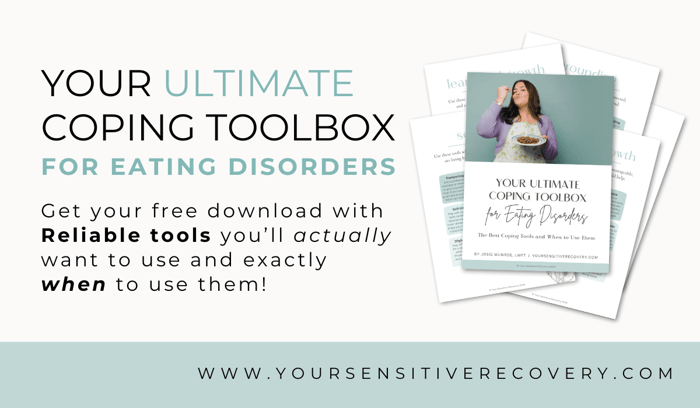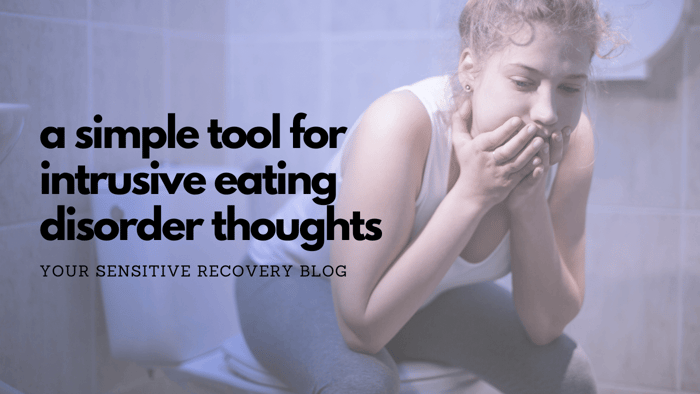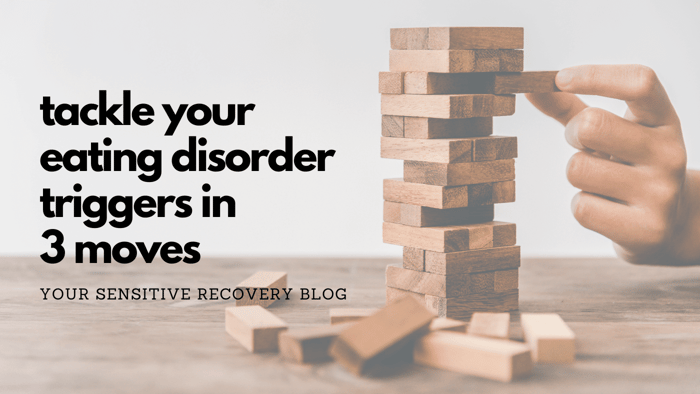When you hear someone say "coping tools," what comes to mind? Maybe deep breathing, journaling, or calling a friend. But what about binge eating, alcohol, or dissociating? The latter are often labeled as “bad” or “maladaptive," yet they, too, are coping tools. They're the ones we may turn to when we don’t yet have access to or the energy for something that feels safer and more supportive for our wellbeing and our goals.
If you're in recovery from an eating disorder or an addiction, it’s not uncommon to feel ashamed of how you’ve coped. But here’s the truth: every coping tool is valid and serves a purpose.
In this post, I'm sharing why shifting your perspective on coping matters, and how releasing the stigma around certain tools can actually help you build the ones that will support you even more.
What Are Coping Tools, Really?
The term coping tools essentially means any number of strategies that we use (both consciously or subconsciously) to help us get through difficult moments - be it intrusive thoughts, challenging emotions, overwhelming situations, or uncomfortable sensations. These strategies can range from the things that tend to get applauded in recovery spaces, like grounding and mindfulness exercises, to behaviors that are looked down upon or pathologized, such as isolating, skipping meals, or using substances.
But here’s the thing, all of these are legitimate coping tools.
When we’re overwhelmed, our brain works quickly to protect us. We may be 100% physically safe but our nervous system can respond as if we are actually threatened. Sometimes the way to "protect" ourselves means reaching for a breathing technique we learned in therapy, and sometimes it means slipping into old patterns that once felt like the only way to survive. In both cases, the intention is the same: to reduce distress and regain a sense of control or comfort.
It’s easy to assume that only certain kinds of coping tools “count," but this mindset can be misleading, and even harmful. If we only validate socially acceptable or recovery-approved tools, we miss out on an opportunity to understand why these not-so-supportive tools developed in the first place. And without that understanding, healing can be more challenging
Language Matters: The Harm in "Good" and "Bad"
It might seem helpful, and sometimes even motivating to call certain coping tools “bad” or “unhealthy.” But this kind of labeling can do more harm than good, especially in the context of recovery. When we label a coping tool as “bad,” we’re not just judging the behavior...we’re also judging ourselves. And that self-judgment fuels shame.
Shame is one of the most powerful and painful forces behind lapses, relapses, and the "stuck" feeling in recovery.
We can never shame ourselves into better behavior. Shame does not and will not create lasting change. Instead, it perpetuates self-blame, secrecy, hopelessness, and often more of the very behaviors we’re trying to shift.Labeling coping tools as "bad" also sets up a rigid dichotomy: either we're coping the “right” way, or we're failing. This black-and-white thinking can make people feel like there’s no point in trying unless they’re doing it perfectly.
Recovery is extremely nuanced and personal. When we remove the morality from coping tools and instead focus on their function, (what they’re trying to do for us) we create space for understanding, change and more empowered choices.
Seeing Coping Through a Compassionate Lens
Instead of sorting coping tools into categories of “good” and “bad,” what if we looked at them through the lens of compassion and context?
Every coping tool (yes, every one) developed for a reason. Often, it was the most accessible option available at the time, or it was the only thing that provided the kind of relief we were seeking. Behaviors like purging, drinking, or shutting down aren’t random or irrational. They are protective strategies, especially when someone is overwhelmed, unsupported, or under-resourced.
This doesn’t mean those tools are sustainable or that they serve you in the long-run. But it does mean they make sense.
Using compassionate reflection can lead to insights and alternatives that feel empowering, not punishing. It also remind us that coping evolves. As we build new skills, safety, and support, our coping toolbox naturally expands, and we may find that some of our go-to tools no longer serve the same purpose or produce the same results.

Self-compassion helps reduce our internal resistance to change. When we're not stuck in self-blame, we're more able to explore new coping tools from a place of curiosity rather than fear hesitancy.
Reflecting on Your Own Coping Tools
Practice observing and assessing our own coping patterns and habits without judgment and through a lens of compassion. Here are some questions to ask yourself:
- What behavior do I engage in and when do I tend turn to it? Explore one of your go-to strategies and the kinds of experiences (internal and external) that prompt the urge for it.
- In what ways has this coping tool helped me survive? This is not a trick question. Feel free to explore how you genuinely think it helped you.
- What's the intention behind me using the tool now? What need am I trying to meet? What are you trying to do with your coping tool? Spending time in solitude and isolating are technically the same behavior, but the intention and unmet need behind each can be quite different.
- How do I feel while I'm engaged in the behavior? And after? Compulsively eating sugary foods may feel very soothing to your senses and your mood in the moment, but are you crashing afterward or dealing with an upset stomach? Sometimes harmful coping tools can still feel "worth it" - and that's ok - we're just noticing.
- What else could I try instead of or alongside of this behavior? Is there another activity that produces a similar positive response (even if it's slower and less intense) that I don't tend to feel bad about in hindsight? When we're looking to stop using certain tools, it's often more useful to think about what you can add to your toolbox instead of what you "should" take away.
In the beginning, it can be helpful to pair tools. For example, if you're trying to decrease binge eating, start by engaging in another tool or two first, like journaling and walking your dog, giving yourself to permission to use food after if the urge for the food has not shifted or has intensified. That may sound counter-intuitive but it has helped a lot of my clients urge-surf and not feel completely powerless to make choices.
Don't be afraid to experiment and personalize your tools. After all, they are YOUR coping tools.
Closing Thoughts: No Shame in Surviving
All the coping tools you’ve ever used have had something in common: they've helped you survive...even the ones you wish you could forget...and even the ones you’re trying to let go of now.
Removing the shame makes space for something that's not only more sustainable but perhaps kinder to your body, mind, and spirit. With compassion, we can stop fighting with ourselves and start listening to what we’ve needed all along.
You don’t have to be perfect to be recovering. You've got this. 💕
✨ Josie Munroe, LMFT is a licensed therapist and owner of JosieMunroe.com and Your Sensitive Recovery. As a recovered clinician and Highly Sensitive Person, she loves supporting others on their journeys to form new, empowered relationships with food, their bodies, and their sensitivity. Join the newsletter for a weekly boost of hope and inspiration. You deserve a recovery that works for you! ✨





